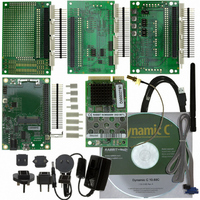101-1285 Rabbit Semiconductor, 101-1285 Datasheet - Page 37

101-1285
Manufacturer Part Number
101-1285
Description
DEV KIT DELUXE MINICORE RCM5600W
Manufacturer
Rabbit Semiconductor
Series
MiniCore™r
Type
Transceiver, 802.11 b/gr
Datasheet
1.101-1285.pdf
(130 pages)
Specifications of 101-1285
Frequency
2.4GHz
Processor To Be Evaluated
Rabbit 5000
Processor Series
RCM5600W
Interface Type
RS-232, USB, PCI
Maximum Operating Temperature
+ 55 C
Minimum Operating Temperature
- 30 C
Operating Supply Voltage
3.15 V to 3.45 V
Silicon Manufacturer
Rabbit Semiconductor
Silicon Family Name
RabbitCore
Kit Contents
Board
Features
On-board Single-Chip 802.11b/g Transceiver, Built-In Web Server
Development Tool Type
Hardware /
Rohs Compliant
Yes
For Use With/related Products
RCM5600W
Lead Free Status / RoHS Status
Not applicable / Not applicable
Other names
316-1161
4.2 Serial Communication
The RCM5600W board does not have any serial level converters directly on the board.
However, an Ethernet or other serial interface may be incorporated on the board the
RCM5600W is mounted on. For example, the Serial Communication accessory board in
the Deluxe Development Kit has an RS-232 transceiver, and the Interface Board has USB
connections.
4.2.1 Serial Ports
There are six serial ports designated as Serial Ports A, B, C, D, E, and F. All six serial
ports can operate in an asynchronous mode up to the baud rate of the system clock divided
by 8. An asynchronous port can handle 7 or 8 data bits. A 9th bit address scheme, where
an additional bit is sent to mark the first byte of a message, is also supported.
Serial Port A is normally used as a programming port, but may be used either as an asyn-
chronous or as a clocked serial port once application development has been completed and
the RCM5600W is operating in the Run Mode.
Serial Port B, shared by the RCM5600W module’s serial flash and by the A/D converter in
the Wi-Fi circuit, is set up as a clocked serial port. Since this serial port is set up for syn-
chronous serial communication, you will lose the peripheral functionality if you try to use
the serial port in the asynchronous mode.
Serial Ports C and D can also be operated in the clocked serial mode. In this mode, a clock
line synchronously clocks the data in or out. Either of the two communicating devices can
supply the clock.
Serial Ports E and F can also be configured as SDLC/HDLC serial ports. The IrDA proto-
col is also supported in SDLC format by these two ports. Serial Ports E and F must be con-
figured before they can be used. The following macros show one way to do this.
OEM User’s Manual
#define SERE_TXPORT PEDR
#define SERE_RXPORT PEDR
#define SERF_TXPORT PFDR
#define SERF_RXPORT PFDR
NOTE: Since Serial Port B is shared, exercise care if you attempt to use Serial Port B for
other serial communication. Your application will have to manage the sharing negotia-
tions to avoid conflicts when reading or writing to the devices already using Serial Port B.
Any conflict with Serial Port B while the RCM5600W is powering up may prevent an
application from loading from the serial flash when the RCM5600W powers up or resets.
Do not drive or load the Serial Port B or SCLKB (PC4, PC5, and PB0) pins while the
RCM5600W is powering up. The serial port B pins should not be reallocated for general
purpose I/O.
31




















